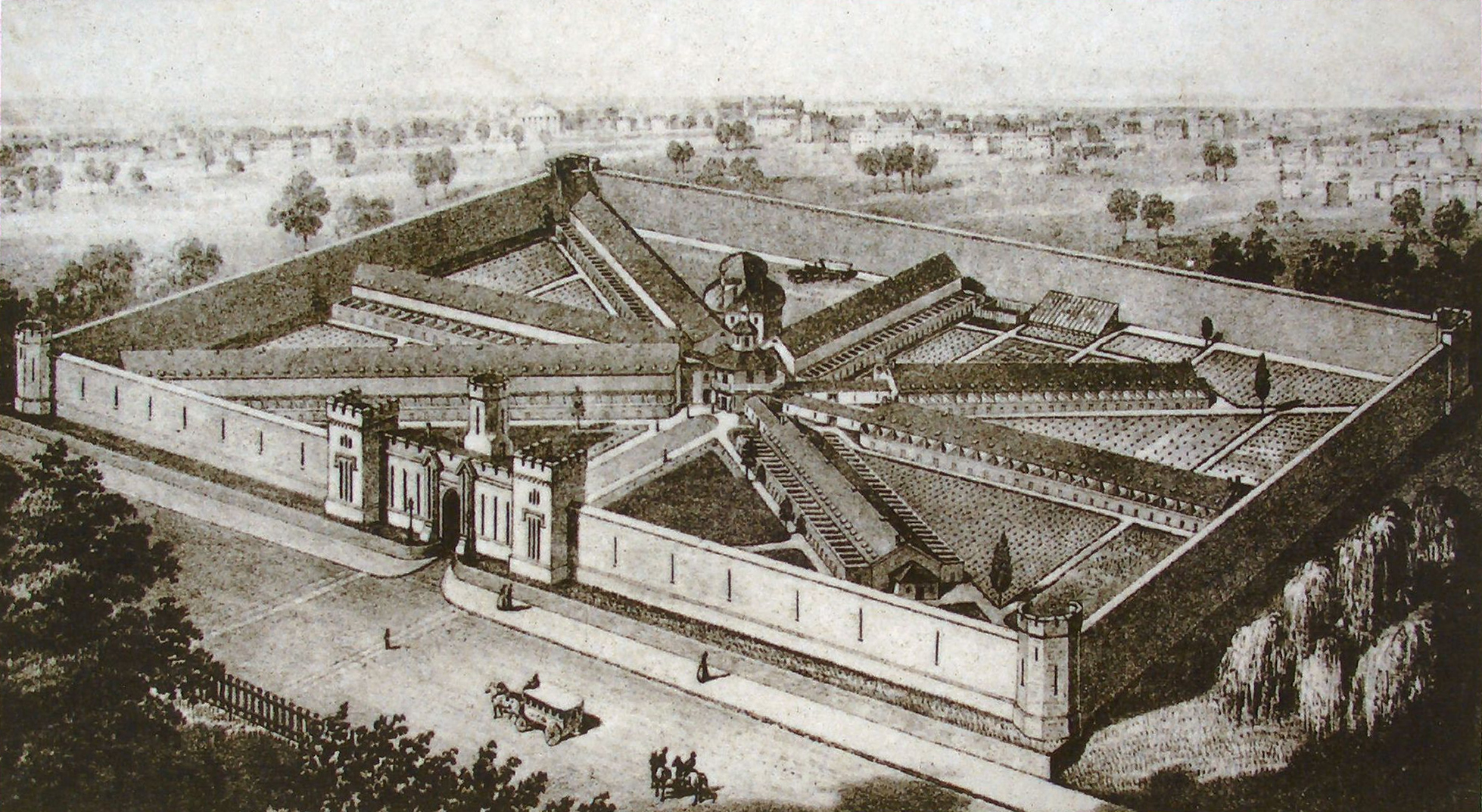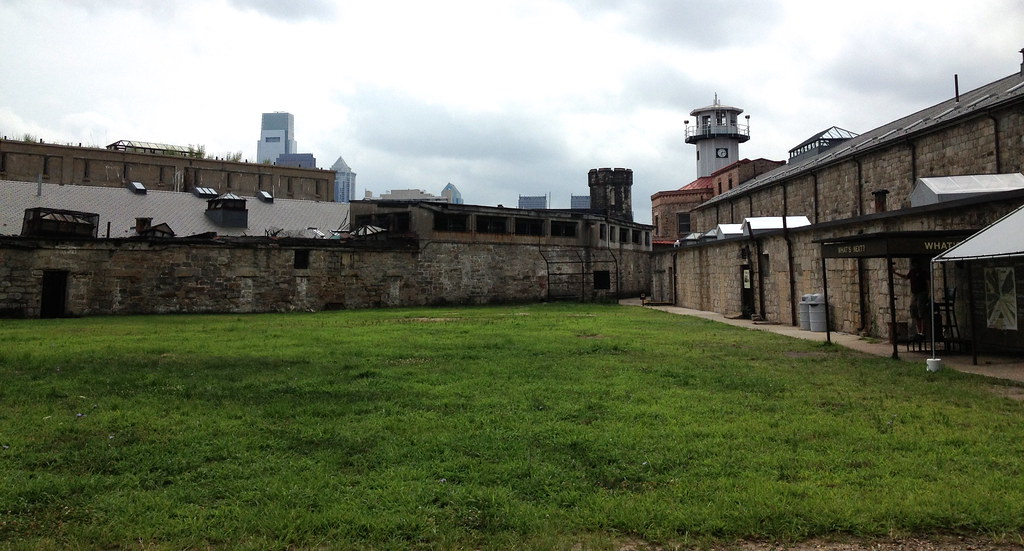The last tourist stop on Sasha's and my East Coast adventure was about as conceptually far away from
Longwood Gardens as you could possibly get, though it featured alongside the botanical site on Philadelphia's list of favorite attractions. It was one of the more unusual places I've ever visited on a vacation, but also one of the more unique and fascinating. It was the
Eastern State Penitentiary.
 |
| Exterior of the Eastern State Penitentiary. Image courtesy of Cheap Date Philadelphia, because I was too busy trying to take atmospheric shots inside the penitentiary to think about getting any exterior views of the facility. |
Prior to heading to the penitentiary, we told a few people about our plans, and the response was always the same: Why go there? Partly it was because of the site's inclusion on the city's must-see list (attraction #18 on the Visit Philly
website), and partly it was because I thought I might be able to get some interesting photos there. Above all else, though, I was interested in doing something new and different; I've been in many historical and run-down buildings--castles, churches, asylums, and homes, to name but a few--but I've never been in a penitentiary, either new or old.
 |
| Lithograph showing an aerial view of the penitentiary, 1855. Image courtesy of Wikimedia Commons. |
Until Sasha and I began our tour, neither of us realized the historical significance of Eastern State Penitentiary (ESP)--not only to Philadelphia, but to the US and the rest of the world. It was hugely influential in shaping an entire era (beginning in 1829) of penal reform--one focused not so much on punishing criminals, but on helping them to contemplate their mistakes so that they might realize the error(s) of their ways, and use the knowledge to improve themselves.
 |
| A typical individual cell at Eastern State Penitentiary. Image courtesy of Ideastream, which features a nice article about the benefits and drawbacks of solitary confinement. |
To facilitate an appropriate level of thoughtfulness and penitence, reformers housed inmates in individual cells and forbade them to talk to each other. The cells were, predictably, quite small, and each one featured a little door leading outside to a private exercise "yard" (a glorified term for such a tiny space). During the day, inmates were expected to sit and meditate; their only diversion was a Bible and occasional visits from religious advisers and caretakers. At least, that's how it was in the beginning; later prisoners were given tools and materials for tasks such as shoe-making.
The penitentiary was quite large to begin with, but eventually grew to such a size that it was no longer feasible to enforce the strict limitations on contact between inmates; whole new wings had to be added to accommodate the expanding population, and the facility included all the sorts of places you'd find in a town--a chapel, a barbershop, a hospital and dentist, and so on.
 |
| Hallway where the interior portion of the audio tour begins |
We learned these facts and more by taking an audio tour (included in the price of admission) around the facility. Amazingly, the tour is narrated by Steve Buscemi, who evidently visited the penitentiary to see whether it might be a good place to film. There are approximately a dozen or so "listening points" associated with the main tour, but you can also select a couple dozen extra recordings to hear details about issues that are a bit tangential to the main narrative (e.g., jailhouse hauntings). These recordings feature the voices of people who are experts on the topics they discuss, which adds some variety to the tour.

The penitentiary is a massive facility, and only a portion of it is open for touring. The public areas have, to some extent, been cleaned and fixed up so as to be safe for visitors, but the whole place is still pretty rough and eerie looking. I think this adds to the appeal of the site, since it makes the place dramatic and mysterious. However, it also does make you feel a bit like you're doing a ghost tour, when in fact there is some very real and interesting history there (though there is also a
haunted house in the autumn). I think the nonprofit organization that runs the penitentiary would probably love to fix up more of the facility, and/or to do a more extensive renovation of the bits that are already visitable, but I'm guessing the funding is just not available. When we were there, we passed several signs advertising a
fundraiser aiming to earn $50,000 for the preservation of murals in the chaplain's office. I'm sure that major structural changes would require quite a bit more money than that.
 |
| Unused, and unvisitable, portion of the penitentiary; I took this photo through the bars of a locked gate preventing visitor access. |
One of the more popular portions of the tour is the cell that was inhabited by
Al Capone when he was incarcerated in the prison for 8 months in 1929-1930. His stay at ESP was his first experience in jail, and, judging from the state of his cell, it probably wasn't too awful a punishment--more like staying in a very strict hotel.
 |
| Al Capone's cushy cell. Image courtesy of About.com. |
Once you've completed the official tour, you are free to wander around the grounds or head back inside to spend more time in the cell blocks you've already visited. We did a little of both, allowing me to get some panoramic shots out in the yard. The site reminded me of a mixture of the
Athens Asylum, a former mental institution in my hometown, and the
Eastern State Hospital, one of my field work sites in Williamsburg, Virginia. It's weird to say that I felt "at home" at a jail, but there was a sense of familiarity and comfort thanks to my previous experience in those similar places.
 |
| Panoramic shot taken outside the cell blocks. Our tour occurred in the left-most building you can see in this image. |
 |
| Recreational yard in between the cell blocks. The block at the right in this photo is the same on you can see at the far left in the photo above. The tent in the bottom right corner contained an exhibition on contemporary penal practices. It's depressing; the US has more prisoners than any other country, by a rather huge margin. |
We wandered around for something like 1-2 hours, so I think we definitely got our $14 worth out of each of our tickets. Not only was the tour interesting and out of the ordinary, but it was also available on a Sunday and located within walking distance of restaurants, shopping, lodging, and other attractions. I realize that jail visits aren't everyone's idea of a good time, but I learned a lot and enjoyed myself, so I'd definitely recommend the attraction to anybody who has time to spare in the City of Brotherly Love.









No comments:
Post a Comment